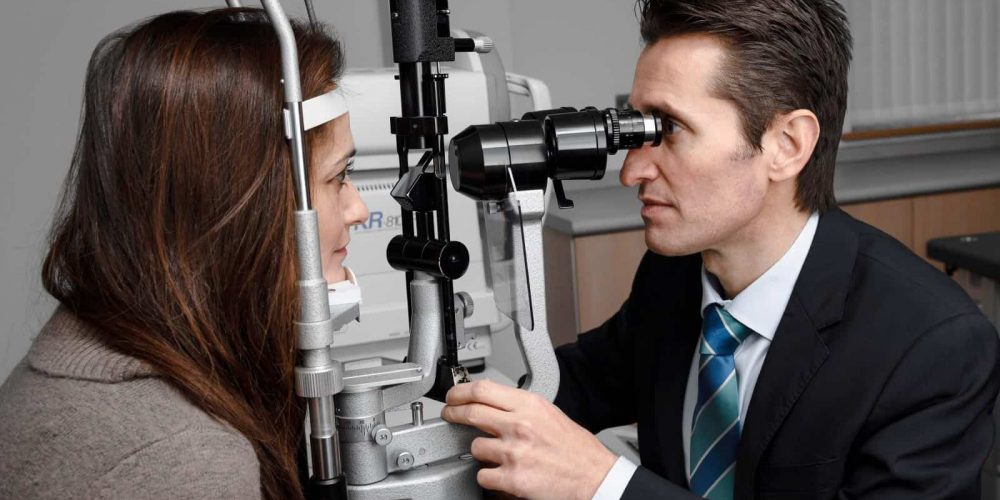Also known as PRK or LASEK, Advanced Surface Ablation is an incisionless procedure with vision restored within 1-3 days. Book your FREE no obligation screening today and find out if you’re suitable.
Advanced Surface Ablation is a routinely performed Laser Vision Correction procedure to reduce or eliminate the need for glasses or contact lenses; it can correct short-sightedness (myopia), long-sightedness (hyperopia) and astigmatism (blurred vision due to the shape of the cornea not being regular). It differs to LASIK as it does not involve the creation of a corneal flap. Instead, the most superficial self-healing layer of the cornea, the epithelium, is removed; the excimer laser then sculpts the cornea, correcting the refractive error.
Advanced Surface Ablation is usually performed if the cornea is too thin for LASIK or the creation of flap is undesirable, such as when hobbies or occupation risk eye injury. Most of these patients can now be treated with SMILE, a new flapless keyhole procedure that is available at Laser Vision Eye Centre.



5 - 10 Minutes per eye
Local anaesthetic (numbing drops)
1 - 2 Days
2 Days recommended
2 - 3 Days
Permanent

Immediately after the procedure you will be taken to your room to rest where the surgeon will check your eyes. You will be given antibiotic, steroid and lubricating eye drops to assist healing of your eyes. You will continue to administer these at home for the next few weeks. Oral pain relief will also be provided. You should arrange for someone to drive you home where you should rest for the remainder of the day.
A key difference between Advanced Surface Ablation and LASIK or SMILE is that following Advanced Surface Ablation the gritty sensation and sensitivity to light are more pronounced and last longer – typically 3-5 days. The improvement in vision is also slower, taking up to 1 month to stabilise. However, the final vision is not inferior to LASIK or SMILE.
You will return to the clinic a few days after your procedure to check your progress. Your Laser Vision Eye Centre surgeons, David or Aris, will review you at this visit. You will also have check ups at 1-2 weeks and 3 months.
If you are considering a loan for the procedure, Nuffield Health can offer a personal medical loan through a third party with 0% for 6, 10 or 12 interest-free monthly instalments are available at representative 0% APR. Longer term payment options are also available at 14.9% APR* with no added costs or admin fees. Once you know the price of your treatment, you can calculate your monthly payments.
Frequently Asked Questions about LASEK Eye Surgery
sociated with LASIK eye surgery is small; studies have shown that the likelihood of poorer vision than before the procedure is under 1 in 1000 cases. One commonly quoted concern is that of dry eyes. Significant dry eye after LASIK is uncommon and in most such cases settles with more prolonged use of lubricant drops, typically for 3-4 months. If your surgeon detects dry eye at the consultation prior to LASIK, he may recommend an alternative procedure such as ReLEx SMILE which has been shown to be more protective for potential dry eye.
One of the most worrying complications of laser eye surgery is infection. Fortunately, this is very rare, in less than 1 in 5000 cases. The majority of cases still respond well to different antibiotic treatments and achieve good driving standards vision.
It’s crucial to consult with an experienced eye surgeon before proceeding with LASIK surgery, as they can provide personalised insights into the eye surgery expectations. Post-operative care is essential, as the day after surgery marks the beginning of your recovery. Patients should follow post-operative instructions, such as washing their hands and avoiding water in the eyes the first week, to ensure the best results.
The change in the shape of the cornea and the laser vision correction are permanent. Small changes develop over the first few months until the cornea stabilizes, but good refractive surgeons anticipate them and take them into account when performing the laser treatment. Thereafter, minimal change can develop; this is most usually not related to the refractive surgery and caused by changes in the lens of the eye during the fifth decade of life and beyond. In this eventually, the vision can be restored with a small tweak, called an enhancement.
You may experience a feeling of gentle pressure during the operation. Immediately after surgery, you may notice some heaviness of the eyes or minor discomfort, but with anaesthetic eye drops that you are provided with, the recovery is relatively painless. It is very uncommon for this to persist beyond the first day.
Different types of laser procedures, including LASIK, LASEK and ReLEx SMILE, are available, and your eye doctor will recommend the best option for you depending on your eyes and on what you would like to achieve. With the appropriate assessment, consultation and surgery the vast majority of people experience great success with refractive surgery, providing them with clearer vision and eliminating their dependence on glasses or contact lenses.
How risky is LASEK and ASA surgery? This procedure is very safe, like any medical intervention though it does carry some risks. It is a laser vision correction procedure that is similar to LASIK, but it does not involve the creation of a corneal flap. This avoids potential flap related complications. While complications are rare, some patients may experience side effects such as delayed healing, dry eye, glare or halos around lights after the procedure. It is important to understand that the risks are small and comparable to those associated with other common laser treatments, including LASIK and SMILE.When considering LASIK, it is essential to consult with a professional who can determine if your vision and eye health are suitable for the procedure. The use of advanced laser technology ensures the surgery is precise and tailored to your specific needs, helping with the latest eye health developments to achieve the best results.
When considering vision correction options like LASIK, SMILE or LASEK/ASA, many patients wonder about the pain associated with the procedures. Generally, during the procedures there is no discomfort or pain as anaesthetic (numbing) drops are used. Most patients report feeling pressure rather than pain, and this sensation is temporary. A key difference between LASEK/ASA and LASIK or SMILE is that following the surface procedures (ASA or LASEK) the gritty sensation, discomfort and sensitivity to light are more pronounced and last longer – typically 3-5 days. The improvement in vision is also slower, taking up to 2 – 4 weeks to stabilise. However, the final vision is not inferior to LASIK or SMILE. the majority of patients experience excellent results, it is important to note that no surgical procedure is entirely without risk. Complications can occur, such as dry eyes, glare and, in very rare cases, vision loss. Understanding the potential risks and benefits is essential for making an informed decision about whether LASIK is the right choice for enhancing one’s vision.
es the cornea to improve the refractive properties and thus focus the image sharply onto the back of the eye, the retina. Typically, patients experience improved vision just a few hours after the procedure.
The benefits to your vision and quality of life can last for many years; however, factors such as ageing of the lens of the eye with the development of presbyopia (need for reading glasses) or cataract may affect vision over time especially after the 5th decade of life.
Free yourself from the hassle of contact lenses or glasses and begin your journey to 20|20 vision today.


We're rated excellent on Trustpilot & average 5-stars on Google, Doctify and TopDoctor for the outstanding service we provide before, during & after treatment.
5 - 10 Minutes per eye
Local anaesthetic (numbing drops)
1 - 2 Days
2 Days recommended
2 - 3 Days
Permanent
Nuffield Health Wessex Hospital
Winchester Road, Chandlers Ford,
Eastleigh, SO53 2DW
© Laser Vision Eye Centre 2023. All Rights Reserved.
Enter your details below to get instant access to your free infopack.